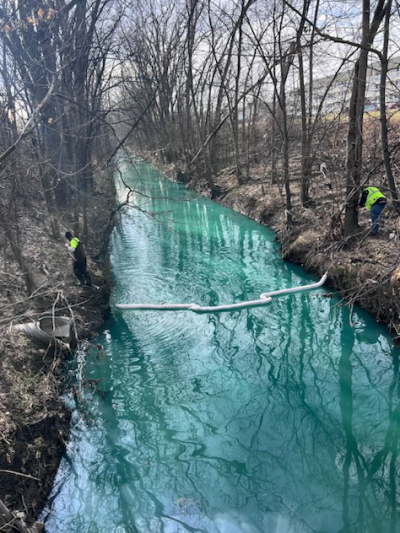
Workers stretch a containment boom over the Bear Creek in Warren.
Photo provided by the Macomb County Public Works Office
WARREN — Macomb County officials have sought expedited testing to determine exactly what chemicals caused the Bear Creek in Warren to turn green with foam on Feb. 7.
The emerald-green water and white foam were discovered by road contractors while they were installing a culvert in the creek for road drainage as part of the Innovate Mound Project, according to Macomb County Public Works Commissioner Candice Miller, who addressed reporters at a press conference on Feb 9.
“They (the road commission) notified us, and we responded immediately. We sent our inspectors on site. We tried to identify what was in the drain,” Miller said. “At first everybody seemed to think it was dye from the sewer testing.”
Nontoxic-strength dies are used in sewer testing, according to Miller.
“But we weren’t sure what it was,” she said.
Because of that, state and federal notification protocols began. The Michigan Department of Environment, Great Lakes, and Energy and the Environmental Protection Agency were notified.
“We then immediately notified the city of Warren. We notified EGLE. We notified the EPA. We notified the Macomb County Health Department.”
The incident originated in an unoccupied building near 10 Mile Road and Mound Road, at 24657 Mound, formerly the site of Fini-Finish Metal Finishing, a metal plating company. According to Miller, the business is now defunct. The building reportedly changed ownership in the fall of 2023 and was not winterized.
“We think now that on Jan. 24 there was a water main break (inside the building),” Miller said. “Because the city of Warren, looking at their water records, all of a sudden had a big spike of water.”
“If you look at the interior of the building, there are different types of materials all over the floor of the building,” Miller added. “Water got to a certain level and washed whatever was there into the storm drain, and it made its way and started working down Bear Creek.”
Inspection determined the exact location of where the contamination originated.
“How they inspect it to get to that point is they look at the manholes all the way up the drain. Until they have identified the source of this contamination. It is unclear exactly how much contamination got into the drain,” Miller said.
Miller added, “We didn’t really notice anything from Jan. 24 until two days ago (Feb. 7). We didn’t notice anything in the drain until then. It took that long, I’m guessing, to get from 10 Mile and Mound, to get to 11 Mile and Mound.”
Containment booms were added in two locations in Bear Creek to corral the materials, according to Miller.
The chemicals were believed to be water soluble.
“There is not a net underneath them (booms). Anything that is water soluble is probably moving through,” Miller said. “They do collect various types of contaminants because most of them do float to the surface.”
Miller added, “That is why we think it is water soluble. It is probably something that has gotten under the boom.”
Booms are able to catch some things but not everything.
“We’re hopeful, I’m hoping that it is,” Miller said, addressing the boom catching some of the chemicals. “I really can’t say with any certainty how much we’ve caught. I’m hoping we’ve caught as much as we possibly can. Whatever was happening is not happening anymore. We stopped that immediately.”
Miller said investigators are 100% sure that no more contaminants are coming from the original site.
“It was closed off immediately. It was closed off on Wednesday (Feb. 7),” Miller said.
A Feb. 12 written release from Miller’s office stated that tests showed no threat to the public, but that aquatic life was potentially impacted.
Test results from EGLE were initially expected by the afternoon on Feb. 9 but were not yet available at press time Feb. 15. The tests will assess water, soil, sediment and ambient air samples, and will check for the presence of 10 metals.
Ahead of the release of the results, officials said they did not believe there was a public health risk when asked about potential contamination of the water used for drinking and bathing.
The case was under the jurisdiction of the EPA. Sources said it was turned over to EGLE because all cleanup activities at Bear Creek were completed on Feb. 9. The booms will stay in place while the inside cleanup continues at the former metal plating facility.
 Publication select ▼
Publication select ▼




















